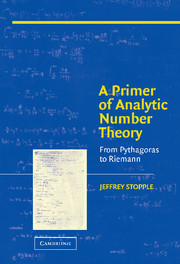
-
Select format
-
- Publisher:
- Cambridge University Press
- Publication date:
- 05 September 2012
- 23 June 2003
- ISBN:
- 9780511755132
- 9780521813099
- 9780521012539
- Dimensions:
- (228 x 152 mm)
- Weight & Pages:
- 0.75kg, 398 Pages
- Dimensions:
- (228 x 152 mm)
- Weight & Pages:
- 0.5kg, 400 Pages
You may already have access via personal or institutional login
Book description
This 2003 undergraduate introduction to analytic number theory develops analytic skills in the course of studying ancient questions on polygonal numbers, perfect numbers and amicable pairs. The question of how the primes are distributed amongst all the integers is central in analytic number theory. This distribution is determined by the Riemann zeta function, and Riemann's work shows how it is connected to the zeroes of his function, and the significance of the Riemann Hypothesis. Starting from a traditional calculus course and assuming no complex analysis, the author develops the basic ideas of elementary number theory. The text is supplemented by series of exercises to further develop the concepts, and includes brief sketches of more advanced ideas, to present contemporary research problems at a level suitable for undergraduates. In addition to proofs, both rigorous and heuristic, the book includes extensive graphics and tables to make analytic concepts as concrete as possible.
Reviews
‘… excellent background reading for undergraduates at any stage of their course.’
Source: Zentralblatt für Mathematik
‘… this is a well-written book at the level of senior undergraduates.‘
Source: Society for Industrial and Applied Mathematics
‘The book constitutes an excellent undergraduate introduction to classical analytical number theory. The author develops the subject from the very beginning in an extremely good and readable style. Although a wide variety of topics are presented in the book, the author has successfully placed a rich historical background to each of the discussed themes, which makes the text very lively … the text contains a rich supplement of exercises, brief sketches of more advanced ideas and extensive graphical support. The book can be recommended as a very good first introductory reading for all those who are seriously interested in analytical number theory.‘
Source: EMS Newsletter
‘… a very readable account.‘
Source: Mathematika
‘The general style is user-friendly and interactive … a well presented and stimulating informal introduction to a wide range of topics …‘.
Source: Proceedings of the Edinburgh Mathematical Society
Contents
Metrics
Altmetric attention score
Full text views
Full text views help Loading metrics...
Loading metrics...
* Views captured on Cambridge Core between #date#. This data will be updated every 24 hours.
Usage data cannot currently be displayed.
Accessibility standard: Unknown
Why this information is here
This section outlines the accessibility features of this content - including support for screen readers, full keyboard navigation and high-contrast display options. This may not be relevant for you.
Accessibility Information
Accessibility compliance for the PDF of this book is currently unknown and may be updated in the future.


